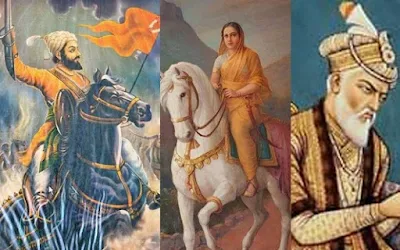Who Defeated The Mughal Empire
 |
| Who Defeated the Mughal Empire |
Internal strife factors for the defeated Mughal empire
Internal strife played a significant role in the decline of the Mughal Empire. Some key factors contributing to internal conflicts and weakening of the empire include:
Succession disputes: The Mughal Empire witnessed numerous succession disputes among the ruling family members, leading to power struggles, civil wars, and instability. The lack of a clear and stable succession mechanism often resulted in internal conflicts and weakened central authority.
Weak rulers: The empire experienced periods of weak and ineffective rulers who were unable to assert control over the vast territories. Incompetent or indecisive rulers failed to address administrative, economic, and military challenges effectively, further exacerbating internal strife.
Factionalism among nobles: The Mughal court was characterized by factionalism and rivalries among nobles and courtiers vying for power and influence. These internal rivalries often led to conspiracies, rebellions, and court intrigues, undermining stability and governance.
Economic decline: Economic mismanagement, including excessive taxation, corruption, and depletion of resources, contributed to social unrest and discontent among the populace. Economic hardship fueled grievances against the ruling elite and eroded support for the central authority.
Administrative breakdown: Inefficiency, corruption, and bureaucratic infighting weakened the administrative machinery of the empire. The decline of centralized administration resulted in the loss of control over provincial governors, further undermining the authority of the Mughal emperor.
Rise of regional powers: Provincial governors, local chieftains, and regional powers began asserting greater autonomy and challenging Mughal authority. The rise of powerful regional states, such as the Marathas, Sikhs, and Rajputs, further fragmented the empire and contributed to its eventual collapse.
External Invasion Factors For The Defeated Mughal Empire
External invasions and foreign interventions played a significant role in the decline and defeat of the Mughal Empire. Some key factors contributing to external pressures on the empire include:
Afghan invasions: The Mughal Empire faced repeated invasions and incursions by Afghan and Central Asian tribes, such as the Pashtuns and Uzbeks, from the northwest frontier. These invasions disrupted trade routes, caused widespread destruction, and posed constant military threats to the empire's stability.
Persian incursions: The Safavid Empire of Persia, under Shah Abbas I, launched several military campaigns against the Mughals, particularly in the Deccan region. The rivalry between the Safavids and Mughals for control over strategic territories and trade routes exacerbated tensions and weakened the Mughal Empire's hold over its western provinces.
Maratha raids: The Maratha Confederacy, a powerful Hindu kingdom in western India, conducted frequent raids and military campaigns against the Mughal Empire, especially during the reign of Emperor Aurangzeb. Maratha incursions into Mughal territories weakened imperial authority, disrupted administration, and drained resources through prolonged conflicts.
Sikh resistance: The Sikh community, under leaders such as Guru Gobind Singh, offered staunch resistance to Mughal rule in Punjab and surrounding regions. Sikh military campaigns, guerrilla warfare tactics, and fortification of key strongholds challenged Mughal dominance and posed a significant threat to imperial authority.
European colonial expansion: The rise of European colonial powers, particularly the British East India Company, posed a growing threat to the Mughal Empire's sovereignty and territorial integrity. British expansionist policies, economic exploitation, and military interventions gradually weakened Mughal authority and paved the way for colonial domination in India.
Internal rebellions: External invasions often coincided with internal rebellions and uprisings by disgruntled nobles, regional rulers, and peasant communities. These internal conflicts further stretched the empire's military resources and undermined its ability to withstand external pressures.
Economic Challenges Factors for the Defeated Mughal Empire
Decline in revenue: The Mughal Empire relied heavily on agricultural taxes, especially land revenue, as its primary source of income. However, over time, the empire faced challenges such as declining agricultural productivity, widespread famines, and inefficient revenue collection systems. These factors led to a decrease in revenue generation, weakening the empire's financial stability.
Corruption and inefficiency: The Mughal administration became increasingly corrupt and inefficient, with officials often engaging in embezzlement, bribery, and nepotism. Corruption at various levels of government undermined the empire's economic resources and hindered efforts to address fiscal challenges effectively.
Depletion of treasury: The Mughal rulers, particularly in the later years of the empire, engaged in extravagant spending on courtly luxuries, grand construction projects, and military campaigns. This lavish expenditure depleted the imperial treasury, leading to financial instability and mounting debt.
Trade disruptions: External factors such as European colonialism and the decline of traditional trade routes disrupted the Mughal Empire's economic ties with other regions. The emergence of European trading posts, such as those established by the British East India Company, bypassed Mughal-controlled trade networks and diverted valuable resources away from the empire.
Inflation and currency devaluation: The Mughal Empire experienced periods of inflation and currency devaluation due to factors such as excessive minting of coins, hoarding of precious metals, and fluctuations in international trade. These economic challenges eroded the purchasing power of the currency, leading to economic instability and social unrest.
Decline of urban centers: Many of the Mughal Empire's once-prosperous urban centers, such as Delhi, Agra, and Lahore, experienced decline and stagnation. Factors such as population displacement, political instability, and the shift of economic activities to coastal regions contributed to the decline of urban economies, further weakening the empire's economic foundations.
Comments
Post a Comment